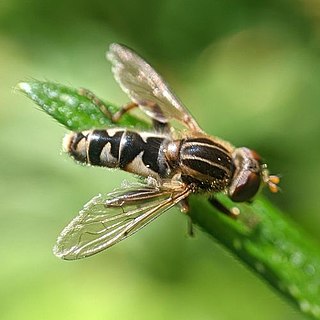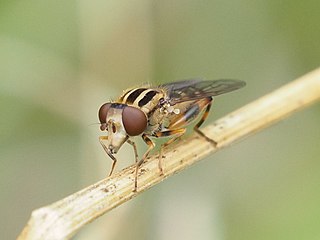
The green darner or common green darner, after its resemblance to a darning needle, is a species of dragonfly in the family Aeshnidae. One of the most common and abundant species throughout North America, it also ranges south to Panama. It is well known for its great migration distance from the northern United States south into Texas and Mexico. It also occurs in the Caribbean, Tahiti, and Asia from Japan to mainland China. It is the official insect for the state of Washington in the United States.

Anasimyia is a genus of wetland hoverflies with aquatic larvae. The genus was formerly regarded as a subgenus of the similar Lejops, and recently elevated to genus.

Lejops is a genus of hoverflies, closely related to the genera Helophilus, Quichuana and Mallota.
Lejops chrysostomus is the former name for a species of syrphid fly which is now called Anasimyia chrysostoma. The old name is still sometimes used for the species.

Arctosyrphus willingii, the northern longbeak, is a species of rat-tail maggot fly in the family Syrphidae. This species was formerly a member of the genus Lejops.
Anasimyia grisescens ,, the Long-spurred Swamp Fly , is a rare species of syrphid fly observed on the Atlantic coast of the United States. Syrphid flies are also known as Hover Flies or Flower Flies because the adults are frequently found hovering around flowers from which they feed on nectar and pollen. They are 7.2–10.1 mm (0.28–0.40 in) long. The larvae are unknown.
Spilomyia foxleei is a species of syrphid fly in the family Syrphidae.

Lejops lineatus is a species of syrphid fly in the family Syrphidae.

Asemosyrphus polygrammus, the common sickleleg, is a species of rat-tail maggot fly in the family Syrphidae.

Anasimyia bilinearis, the two-lined swamp fly, is an uncommon species of syrphid fly observed throughout North America. Hoverflies can remain nearly motionless in flight. The adults are also known as flower flies for they are commonly found on flowers from which they get both energy-giving nectar and protein-rich pollen. Larvae of this genus are of the rat-tailed type living in aquatic environments.

Anasimyia chrysostoma, the lump-legged swamp fly , is a fairly common species of syrphid fly observed across the United States and Canada. Hoverflies can remain nearly motionless in flight. The adults are also known as flower flies for they are commonly found on flowers from which they get both energy-giving nectar and protein-rich pollen. Larvae of this genus are of the rat-tailed type living in aquatic environments.

Anasimyia distincta, the short-spurred swamp fly, is a rare species of syrphid fly observed in The Northeastern United States and adjacent Canada. Hoverflies can remain nearly motionless in flight. The adults are also known as flower flies for they are commonly found on flowers from which they get both energy-giving nectar and protein rich pollen. Larvae of this genus are of the rat-tailed type living in aquatic environments.

Anasimyia anausis , the moon-shaped swamp fly, is a fairly common species of syrphid fly observed across North America. Hoverflies can remain nearly motionless in flight. The adults are also known as flower flies for they are commonly found on flowers from which they get both energy-giving nectar and protein rich pollen. Larvae of this genus are of the rat-tailed type living in aquatic environments.
Arctosyrphus is a genus of rat-tail maggot flies in the family Syrphidae. This genus has a single species, Arctosyrphus willingii. It was formerly a member of the genus Lejops.

Asemosyrphus is a genus of rat-tail maggot flies in the family Syrphidae. There are three described species in Asemosyrphus. They were formerly members of the genus Lejops.

Eurimyia is a genus of rat-tail maggot flies in the family Syrphidae. There are three described species in Eurimyia. They were formerly members of the genus Lejops.
Lunomyia is a genus of rat-tail maggot flies in the family Syrphidae. This genus has a single species, Lunomyia cooleyi. It was formerly a member of the genus Lejops.

Polydontomyia is a genus of rat-tail maggot flies in the family Syrphidae. The genus is monotypic, comprising a single species, Polydontomyia curvipes, also known as the dimorphic sickleleg. It was formerly a member of the genus Lejops.

Helophilina is a subtribe of rat-tail maggot flies in the family Syrphidae. There are about 19 genera and more than 180 described species in Helophilina.













